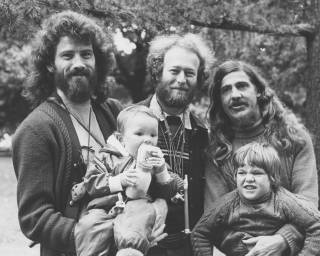 |
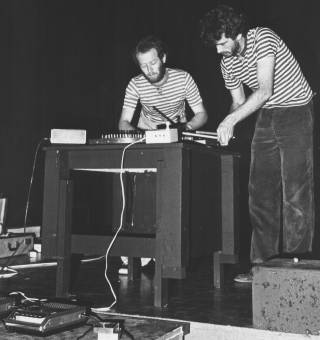 |
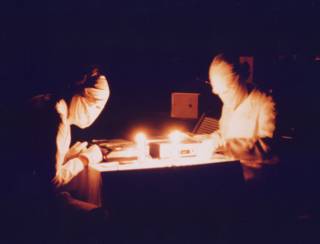 |
 |
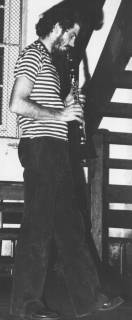
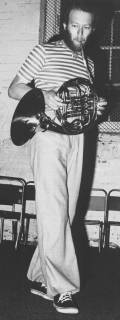
|
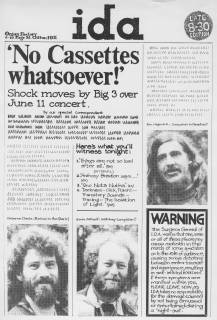 |
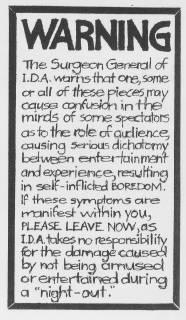 |
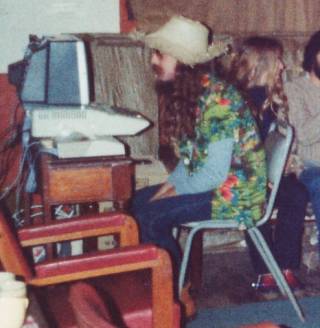 |
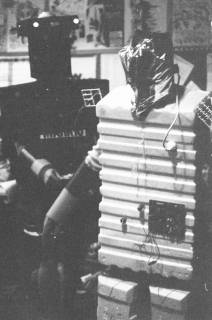 |
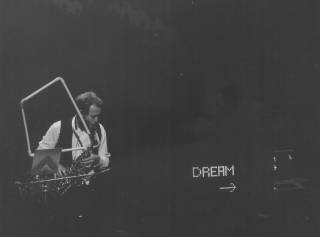 |
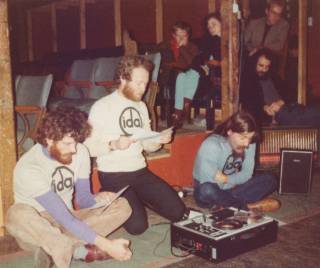 |
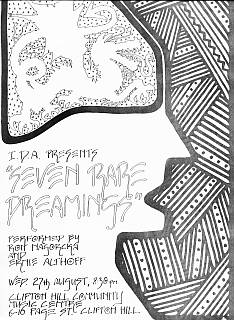 |
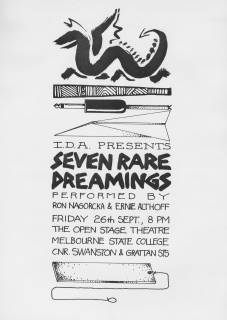 |
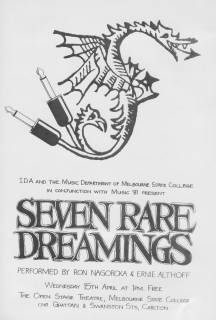 |
IDA stands for Institute for Dronal Anarchy
The history of an ensemble, 1979 – 1983
Ernie Althoff
Formation
One wintery night in 1979, Ernie Althoff visited Ron Nagorcka, who sat at his kitchen table and fiddled with words and their initials on a scrap of paper.
“I'm trying to come up with a good name which includes references to drones and anarchy, and infers more of a loose learning
environment rather than an ensemble that entertains. Warren Burt, the other half of Plastic Platypus, is overseas. Who knows when
he'll be back?”
Fairly quickly, the name Institute for Dronal Anarchy was devised, and the acrostic IDA was whipped up into a logo.
“Who's in this new band of your's?” asked Ernie.
“Aw, you are, I suppose.”
“Gee thanks, I'd like that very much. Only trouble is that last week I discussed forming a duo with Graeme Davis, given our common backgrounds in visual
arts practices.”
“Ok, he's in it too then! You can do more with three, and if we ever need more we can accept people as we go.”
This meeting was the fairly unorthodox (but in some ways typical) beginning of an ensemble that performed radically experimental music for the next three and two thirds years. Centred around the Clifton Hill Community Music Centre [Althoff, Dale] housed at the Organ Factory in the Melbourne suburb of Clifton Hill, IDA featured consistently in concert programs with a large number of works, and developed a strong reputation for serious and diligent experimentation within musical and theatrical frameworks, sometimes pushing the boundaries to puzzling, but always thought-provoking, incomprehension.
Althoff met Nagorcka who taught a Council of Adult Education summer school in electronic music in early 1978, and was then introduced by Nagorcka to the CHCMC (founded by Nagorcka and Burt two years before). Graeme Davis discovered the centre by listening to the experimental music program on community A.M. radio station 3CR, and found the centre's anarchic, no-expectations, non-virtuoso, DIY ethic perfectly suited to his thoughts on his performance-art practice, and to art in general. Through the weekly concerts of voluntary presentations, all three were exposed to each other's work.
Skills and resources – what relevance?
With thinkers Gregory Bateson and Ivan Illich as his new heroes, Nagorcka originally came from a traditionally educated musical background (University of Melbourne) with considerable keyboard skills from many years as a church organist. His academic background earned him the respect of those still tenured, but they certainly disapproved of '...all that Clifton Hill stuff.' The remark “Oh Ron, you're not still doing that drone music!” is recalled. He had also taught himself to play didjeridoo in 1973 (During the IDA years he started making his own). Standard notation was irrelevant within IDA; notation systems appropriate to the work: graphic, text or even just verbal instruction, were utilized. More relevant for IDA were the performance tactics devised by Nagorcka and Burt during their collaboration as Plastic Platypus, with emphasis on classless and consequently low-budget music making with sound sources relevant to those concepts. They championed the use of the portable audio-cassette recorder as an exceptionally good tool for live electro-acoustic performance. [Althoff] This concept so impressed Davis when he first encountered it, that he began to construct musical works of his own, often embedded firmly into his previous artwork practices.Davis studied sculpture at RMIT but became disillusioned in his post-graduate year with the emphasis on the Caro-style of the time. He was also making a name for himself in the performance-art movement of the mid-seventies, a movement then concerned more with post-object ideas of sculpture than the dance/video presentations that it would later devolve into. By day he worked at an aged-care facility as a cleaner, nurse and sometimes occupational therapist. On discovering the inclusive environment at CHCMC, he acquired various instruments: a clarinet, a cheap Chinese french horn, some kalimbas, some ocarinas, two Chinese erhus (a two-string bowed instrument) and a flexatone. With all of these he developed his own playing styles, primarily to load sounds onto his fluctuating collection of cassette players, often in varying states of (interesting) disrepair! Later a grant from the Visual Arts Board led to the purchase of better cassette players, as well as a portable stereo recorder with a binaural dummy-head microphone assembly to go with it.
Althoff worked as a (pre-computer) graphic designer in publishing for the whole of IDA's existence. Growing up next to the radio, and later becoming engrossed in rock bands (live and on vinyl LPs), blues music (both Delta and U.K.), the Glastonbury-prog bands and selected areas of jazz, he had tried to break from his 'listener-only' status by taking alto saxophone lessons in the early 1970s, but living in an upstairs flat got the better of practising. His record collection grew and grew. He knew of composers like Cage, Ligeti and Stockhausen but found their music on LP difficult to approach. More interesting to him were the sounds of bowed cymbals played by Robert Wyatt on a Keith Tippett record, and the extended improvisations of British band Henry Cow on a concerts LP. The prepared and treated guitar LPs compiled by Fred Frith were also a big ear-opener.
Putting aside the saxophone, Althoff's instrument of choice became the Superscope 202LP cassette player (of which he owned two), with an assortment of TDK endless cassette loops of different durations. Similar to Davis, an assortment of toys, found objects and other small wind and percussion objects was collected. Althoff soon added to this by building many of his own instruments. His rock musician friends spoke critically of his forays into 'weird shit'(compare this with Nagorcka, above), but Althoff certainly didn't care – he had a new peer group, and at last he was making his own sound world. Self-released cassettes by Australian and overseas composers were now stored next to the LPs.
Authorship
IDA composed and performed far more duo works than trios, with a smaller number of solo works added for specific contexts. This usually occurred because the third member was not available (day-job commitments, pregnant partners, etc) but Althoff consistently performed in all events. He also did most of the 'management' duties such as phone calls, arranging rehearsals, etc.The compositional process often began with a very informal meeting after the band had been asked or had volunteered to be in a concert. One member might present an idea in some form, the others would then possibly add suggestions or comments. Then the originator of the idea would nail it down into some form so it could be performed. Very occasionally, a familiarity with the resultant textures would be obtained through loose rehearsals.
In a few instances, a piece was composed by a single member and presented in a finished form, with the awareness that, in IDA style, the performance really was the finished form. The major exception to this was “Seven Rare Dreamings” (Nagorcka/Althoff), devised primarily by Nagorcka. He structured the work's seven parts and composed some entirely. Others were discussed with Althoff filling in the fine detail into Nagorcka's basic structure.
There was never a single controlling member in any of the works. A strong awareness of the different skills and perspectives brought into the processes of writing and performing was always present, with all members on an equal footing from the very start.
Playlist
31 Aug 1979 – Electronic Smorgasbord event at Open Channel TV Studios, Fitzroy. Many performers, including three (un-named) solo pieces by Althoff, Davis and Nagorcka. First official appearance of IDA, announced as such.24 Oct 1979 – Accentuate the Positive concert by Althoff at CHCMC. “Nora Dies” and “Freeform Vocal Trio for Handheld Instruments” (Both EA) performed by IDA trio amongst other solo Althoff works.
21 Nov 1979 – IDA at CHCMC concert. Five trios: “Telephobia” (EA), “Yellow Fades Rapidly in Sunlight” (EA), “Slow Decay” (EA/GD), “The Cruel Face of Beauty” (GD), “Conversation Piece” (RN).
9 Dec 1979 – Caulfield Community Day at Caulfield Park (outdoors). Imrov by EA/GD.
19 Dec 1979 – Mixed Bag concert of many performers at CHCMC. Duet (EA/GD) of un-named work by GD.
16 Jan & 6 Feb 1980 – Summer Season improvisation workshops and concerts (7 in all) at CHCMC. These two co-ordinated by EA/GD. Group texture-building works, etc.
16 Apr 1980 – Two Thirds of What We've Got concert of EA/GD duets at CHCMC. Seven duets: “Tautology” (EA), “Terminal Moraine” (EA), “Love is a Beautiful Song” (GD), “The Long and the Short of It” (EA/GD), “”MeMoMu” (EA/GD), “Insufficient Information” (EA/GD), “Longwinded” (improv on long wind insts). [Traviato]
24 May 1980 – New Music Magazine Benefit concert of several performers at University of Melbourne. Trio. “Nora Dies”, “Longwinded”, “Vocal improv”. [Brophy]
25 May 1980 – Malvern Mayor's Park Day at Central park, Malvern. Outdoors improv by EA/GD.
11 Jun 1980 – No Cassettes Whatsoever concert at CHCMC. Four trios: “Anthony Braxton Says...” (EA), “Oh No, Not Another...” (EA), “Darkness – Click, Flash – Transitory Sounds – Tracing – the Isolation of Light” (GD), “Things Are Not So Bad After All” (RN). [Campbell]
26 Jun 1980 – Concert at Open Stage, Melbourne State College, Parkville (the secondary teachers' college where Nagorcka taught, now part of the University of Melbourne). Student and staff performances. “Things Are Not So Bad...” performed by RN, EA and John Crawford.
27 Aug 1980 “Seven Rare Dreamings” (RN/EA) at CHCMC. Concert of single work.[Turner]
26 Sept 1980 - “Seven Rare Dreamings” for Concert Week, Open Stage, Parkville.
6 Oct 1980 – Some Music concert series by CHCMC regulars, La Trobe University Union Gallery, Bundoora. Improv by RN/EA worked up around one of the sections of “Seven Rare Dreamings”.
15 Nov 1980 – Benefit Concert for New Music Magazine at University of Melbourne. Several performers. Three duets by EA/GD: “And It Came To Pass” (EA), “What's All the Shouting About?” (EA/GD), “When the Words of a Song Cannot be Sung, Are the Words of the Song Still There?” (GD, orig. a solo work). [Annear]
8 Mar 1981 – “Environmental Symphony” (RN) for many performers, outdoors at Footscray Park. Nagorcka was composer-in-residence for Footscray during Music '81 (a state funded initiative). EA and GD also perform in it. Billed as Ron Nagorcka and Friends.
11 Mar 1981 – Benefit Concert for New Music Magazine at CHCMC. Several performers, including EA/GD: “Love is a Beautiful Song”.
15 Apr 1981 - “Seven Rare Dreamings” at Open Stage, Parkville. Part of RN's Music '81 presentations.
22 Apr 1981 – Solos concert at CHCMC. “Piece for Kalimba and Two Feedback Circuits” (EA), “Mr Inadequate Finds Smiles in TV Land” (GD), “Atom Bomb Meets Godzilla” (RN, written prior to IDA)
3 May 1981 – IDA Concert at Footscray Community Arts Centre. Part of a series of seven concerts set up by RN for Music '81. Duets by EA/RN: “Gino's Dance”, “Feedback”, “Slowdown Bells” (all EA/RN), “Nora Dies” (duet version), “Accentuate the Positive” (EA solo).
31 May 1981 - “Algorhythm 0” (RN) at Footscray Community Arts Centre. Concert of a single work performed by RN, EA, Sue Elston, Herbert Jercher and Chris Quinlan. Band billed as Foots.
26 July 1981 - “Saltwater River Concerto” (RN) at Footscray Technical School. Concert for Music '81. Performed by RN, EA and two others. Band billed as Ron Nagorcka and Friends.
25 Aug 1981 – International Music and Technology Conference at the Victorian College of the Arts, Melbourne. “Love is a Beautiful Song” (GD) performed by EA/RN.[Burt]
27 Aug 1981 – International Music and Technology Conference at Open Stage, Parkville. “Seven Rare Dreamings” performed by RN/EA.
14 Oct 1981 - “Algorhythm 0” at CHCMC. Single work performed by RN, EA, Sue Elston, Herbert Jercher and Richard Vella. Band billed as IDA.
1 Nov 1981 – Workshop with homemade musical instruments at Footscray Community Arts Centre. Run by RN/EA for Music '81.
20-29 Nov 1981 - “4D” Exhibition of Sight and Sound at Footscray Community Arts Centre. Co-ordinated by RN for Music '81. Invented instruments by GD and RN amongst others. Early electrical kinetic sound sculpture by EA exhibited.
14 Apr 1982 – Music by Ron Nagorcka at CHCMC. Seven duets by EA/GD: “Tumbling into the Snare of Dreams”, “Sometimes your Bent Function” (3 realizations), “Six Numbers Converging on an Animal”, “Sonambulism” and “The Scarlet Aardvaark” (this piece unfinished by RN since 1975, finished off by EA/GD to performance state). This was the final IDA concert.
14 Apr 1983 – IDA trio recording session of “Divide by 4? No, Divide by 3” (EA/GD/RN) at Melbourne Council of Adult Education studio. Produced by Warren Burt for the Public Broadcasting Association of Australia's Composing for Radio tape series. [McDonald]
Notes on some selected works
“Yellow Fades Rapidly in Sunlight” (EA 1979) is a good example of live cassette player performance from the time. Three players sit in a large triangle, each equipped with a small, high-pitched instrument, a cassette player loaded with a normal tape (i.e. not a loop) and an external microphone on a long cable running over to the next player. The player's internal mic. functions when the external mic. is disconnected. This is important to the piece, as players need to record themselves or the other player. Each player has a score of instructions to be worked through, using arbitrary timing. The three scores are the same 10 operations, but in different sequences. Operations such as 'Play and record self', 'Total tape rewind', 'Record other', 'Playback tape' and 'Play and playback tape' build a constantly varying texture with unpredictable dynamics and increasing upper level harmonics. [1]Slightly more complex is ”The Long and the Short of It” (EA/GD 1980). Here the three cassette players used have varispeed function, and are set slow, normal and fast (varispeed only works on playback). The 'artiste' (labelled with a head sign) plays long tones on a variety of small wind instruments and some sustained percussion. Three microphones feed the sounds to the 'technician' (also labelled) who uses the players' Pause and Record controls to cut tiny segments from these tones onto tape loops. There is certainly room for virtuosic dexterity here! As the piece builds and the loops phase and repeat, a strange little melodic snippet can appear, only to be altered with the next batch of recordings. In an academic thesis, Melbourne composer Robin Fox has lauded this piece and its demonstrated processes as an important analogue forerunner to the role of digital sampling in modern computer music.
“Terminal Moraine” (EA 1980), performed on the same program, uses the same equipment. For this piece, the Pause control edits the sharp attacks from percussion on a large zither, leaving the close-miked fading string vibrations to build up the final texture.
Describing “Love is a Beautiful Song” (GD 1980) in an article published in 1982, Warren Burt stated:
“In a darkened room lit only by candles, the audience (about 100) sits facing the centre. From six cassette recorders placed around the
perimeter, sounds of birds on a lake emerge. From time to time, a familiar tune, whistled, appears on the tapes as well. Two performers,
one playing a clarinet, the other a saxophone with long bits of plastic tubing placed between the mouthpiece and the body, play long low
sustained tones as they slowly move about the audience, keeping a large distance between themselves as well. The performance combines
elements of ritual (darkness, processional, dirge-like sounds) with elements of the absurd – as the whistled tune comes back again and
again, and yet again and again, sometimes alone, sometimes in canon with itself, sometimes in a massed heterophonic chorus, it assumes a
status both monumental and ludicrous... ...Performed at the International Music and Technology Conference, Melbourne, (the piece) is
remarkable not only for its technical aspects – Davis gets the most clean sound imaginable with the cheapest possible equipment – but also
for its air of sustained concentration. Using only the simplest equipment, and the most rudimentary musical technique, (the players) not
only put themselves forward as examples of a musical 'do-it-yourself' aesthetic par excellence, but they achieve with it a tightly knit
unity that leaves their more technically endowed colleagues impressed and envious”. [Burt]
In 1980, the music department of Melbourne State College acquired an Apple ll microprocessor – state-of-the-art computer equipment for the time. With about 32 kB of memory and no software packages, the only way into it was through a primitive programming language learnt by playing space-invader games. Its big advance was that , once the language was learnt and some programs written, it performed its operations on the spot – a huge advance from having to wait a week to see whether your cards had been punched correctly! A primitive printer allowed numbers and letters to be printed on a 115mm wide roll of paper, and enough sine, square and sawtooth wave information allowed realtime composition of simple polyphony.
Nagorcka quickly taught himself the language and started building tools. A random number generator was designed to spit out numerical sequences, and later to organize a stored vocabulary into bizarre dada-esque stanzas of poetry. He also exploited the realtime aspect to turn the computer into a performance device, making “Things Are Not So Bad After All” (RN 1980) and “Seven Rare Dreamings” (RN/EA 1980) among the first live performances of computer generated music in Australia. [Gerrard]
“Things Are...” was a rambunctious piece of almost chaotic audience participatory music theatre – certainly not a positive start for any future computer reverence! Clad in tropical-island castaway clothes, Nagorcka controlled the Apple ll on the 'island'. Nearby, a table was piled high with toy pianos, organs, xylophones and other keyed and numbered instruments. As the audience entered the space, they were met by two formidable 'robots' (Althoff and Davis clad in homemade outfits of cardboard, polystyrene packaging, discarded electronic circuitry and bent coat-hangers). The robots lumbered over to the printer every time Nagorcka played a 12-tone row, tore off the strip of paper on which more random rows were printed, and then almost bullied audience members to accept the paper as a score, select an instrument from the table, and begin improvising on their personal score. Once the audience got over their initial surprise and trepidation – quite quickly because, after all, this was CHCMC – much fun was had by all. When the piece was performed a second time at Melbourne State College, students shouted with happy recognition when the robots appeared from behind a curtain!
“ “Seven Rare Dreamings” is a music-theatre event with a refreshingly rich array of aural and visual components, genuine humour and human warmth. This is no exercise in artistic abstraction or esoteric ritual, but an earthy exploration of culture and mythology, old and new. At one point in the performance it seemed to me that I could have been witnessing an ingeniously illustrated lecture in anthropology, such were the immediacy and symbolic power of the materials used. But this, surely, is the mark of good drama: that it presents or provokes mind-broadening insights about the human experience”. Thus wrote Paul Turner in New Music Magazine No. 3.
To describe comprehensively even the workings of the piece is not possible here. Mention can be made of the role of the computer, which occupied a position as third performer on stage. Pre-programmed by Nagorcka, and moved to the next operation in the piece by Althoff pressing the spacebar, audio signals were sent to a P.A. system and screen images to a large second (colour) monitor attached to the theatre track-lighting assembly. Patterns of computer graphics played across the screens in the first two sections, five different melodies filled the third, and random poetry appeared on screen and through the printer to be read by Althoff in the fourth. The fifth section was the computer's tour de force: a steadily ascending series of sustained and overlapping pitches building in volume and intensity backed Nagorcka's didjeridoo and Althoff's similarly pitched growling tube-extended saxophone in a tight trio.
The Open Stage theatre at Melbourne State College became a well-equipped home for the piece after its debut at CHCMC. Here there were a P.A. and desk for the four air-mics and the computer (housed on a trolley in the same building), the second monitor, spot lighting, a pulldown screen and colour-slide projector, raked audience seating and enough risers, panels and tables to be able to stage the hour-long work successfully and with maximum impact. Yet, despite these nods towards professional drama, the piece remained unmistakeably homemade music-theatre.
“Divide by 4? No, Divide by 3” (EA/GD/RN 1983) was IDA's last work and its first work in a recording studio. Warren Burt commissioned the work as one of a series to be duplicated onto reel-to-reel tapes and distributed to PBAA subscriber stations. Burt specified a 25 minute piece that could be recorded simply i.e. no multitracking and mixdowns, but that wasn't a problem for IDA. Althoff proposed the idea of filling 100 15-second units with material that largely addressed the medium of radio – its invisibility, its imagination potential, its distance traversing capacity, and the phenomenon of the performers 'letting a work go' into realms of unknown possible ambiguity compared to the live performance environment. The others agreed, and all three went off to compose their parts.
On the evening of the session, Althoff brought his score as planned, some aluminium bowls that sounded like the ABC radio chimes of old, two loaded cassette players and a stopwatch. He was rather disappointed to see Davis's score was only a few statements written on cards and some electronic children's toys, and Nagorcka hadn't written anything but had just marked a few passages in some books he had brought along. He needn't have worried – the old IDA performance bond was still in evidence as strong as ever! By a stroke of luck, the studio had an upright piano and a very old chrome-cased radio microphone that acted as an extreme filter, and Nagorcka commandeered both. Burt set up the required number of microphones, set the levels on the desk, and counted the piece in. Half an hour later, with the finished piece on the spool, the three sat back, grinning with mutual satisfaction.
Althoff's favourite part of the piece is the ending: he has just completed his alphabetical list of Australian towns that runs through the whole work – “Zeehan? ... Zetland? ... Zillmere?” - when Davis hesitatingly suggests “Hey, hey ... let's start again!”
Burt's taped introduction to the work includes this quote:
“...(the work) proposes a structural model of a functioning anarchy, a model based on freedom and co-operation rather than regulation and competition. In this sense then, their (IDA's) work can be seen as political, for it proposes structural models to society different from the ones we now have”.
Footnote
[1] This piece was performed a decade later by Perth ensemble Alea (Paul Tanner, Cathie Travers and Lindsay Vickery) in a concert on 21 Apr 1989 at the University of Western Australia. The concert was reviewed by Stuart Hille in The West Australian on 24 Apr 1989 (Fascinating Music Form Has Share of Problems, p 84) and the piece mentioned. return
Further Reading
1. Althoff, E.: “The Clifton Hill Community Music Centre 1976-1983”, NMA 7, NMA Publications, Melbourne, 1989, pp 39-43.2. Althoff, E.: “Ferric Oxide Archaeology"
3. Annear, J.: “Review of 15 Nov 1980 Benefit concert”, New Music No 4, Melbourne, 1980, pp 4-5.
4. Brophy, P.: “Review of 24 May 1980 Benefit concert”, New Music No 2, Melbourne, 1980, pp 5-8.
5. Burt, W.: “Seven Composers in Three Parts”, Art Network No 6, Sydney, 1982, pp 36-38.
6. Burt, W.: “Thirty Years of Australian Experimental Music 1963-1993”, Sounds Australian No 37, Australian Music Centre, Sydney, 1993, pp38-47.
7. Dale, J.: “Once Upon a Time in Melbourne”, The Wire 272, London, UK, 2006, pp 32-37.
8. Gerrard, G.: “An Interview with Ron Nagorcka”, NMA 2, NMA Publications, Melbourne, 1983, pp 4-6.
9. Jenkins, J.: 22 Contemporary Australian Composers, NMA Publications, Melbourne, 1988.
10. Campbell, J.: “Review of IDA 11 Jun 1980 concert', New Music No 2, Melbourne, 1980, pp 25-36.
11. McDonald, J.: “PBAA National Program Service – Contemporary australian Recorded Music Project”, AMC News No 9, Australian Music Centre, Sydney, 1985, p 21.
12. Traviato, R.: “Review of IDA 16 Apr 1980 concert “, New Music No 1, Melbourne, 1980, pp 37-44.
13. Turner, P.: “Review of IDA 27 Aug 1980 concert”, New Music No 3, Melbourne, 1980, pp 14-17.